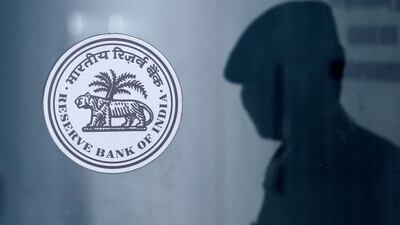India's central bank kept rates steady at record low levels as expected on Friday and said it would maintain support for the economy's recovery from the pandemic by ensuring ample liquidity for markets to absorb a massive government borrowing programme.
"Going forward, the Indian economy is poised to move in only one direction and that is upwards. It is our strong conviction, backed by forecasts, that in 2021-22, we would undo the damage that Covid-19 has inflicted on the economy," Reserve Bank of India governor Shaktikanta Das said after announcing the rate decision.
The repo rate or RBI's key lending rate was held at 4 per cent while the reverse repo rate or its borrowing rate was left unchanged at 3.35 per cent.
The repo rate has been cut by a total 115 basis points since March 2020 to cushion the shock from the coronavirus pandemic, following a 135 bps reduction since beginning of 2019.
Mr Das said the six members of the monetary policy committee (MPC) were unanimous in their decision to keep rates on hold.
He said that the economy's growth outlook had improved and that inflation was expected to remain within the RBI's targeted range over the next few quarters.
"Given that inflation has returned within the tolerance band, the MPC judged that the need of the hour is to continue to support growth, assuage the impact of COVID-19 and return the economy to a higher growth trajectory," Mr Das said.
Inflation readings over the last two months have been better than the MPC had expected when it met in December, Mr Das said while stressing that price stability remains the foundation on which the economy can reach its potential.
"Outlook on growth has improved significantly with positive growth impulses becoming more broad-based and the rollout of the vaccination programme in the country auguring well for the end of the pandemic," he added.
With the economy bouncing back from a low base after this pandemic stricken year, the MPC has projected GDP growth of 10.5 per cent for the fiscal year starting April.
After a severe contraction in the June quarter showed India had been one of the major economies hit hardest by the pandemic, a pick up in manufacturing resulted in a much smaller contraction in the September quarter.
The MPC saw retail inflation running at 5.2 per cent in the current quarter, and expected it to be between "5.2 per cent to 5 per cent" in the six months from April through September.
Mr Das said the recent budget proposals and expenditure plans have raised hopes for a more robust recovery, and the bank stood ready to offer support and also ensure that the government's 12.06 trillion Indian rupees ($165.42 billion) borrowing programme for the coming fiscal year was absorbed smoothly by the market.
"Importantly, the RBI talked about supporting growth," said Kunal Kundu, India economist at Societe Generale.
"We would likely see the RBI coming to the aid of the government, even in the fiscal space either by opting for debt monetisation or sharing a portion of their excess reserves."
The blue chip Nifty 50 index was largely unchanged while the S&P BSE Sensex was up 0.59 per cent after the central bank kept key rates steady.
The rupee strengthened marginally to 72.91 against the dollar, while the benchmark 10-year bond yield rose to 6.15 per cent compared to its previous close of 6.10 per cent.

